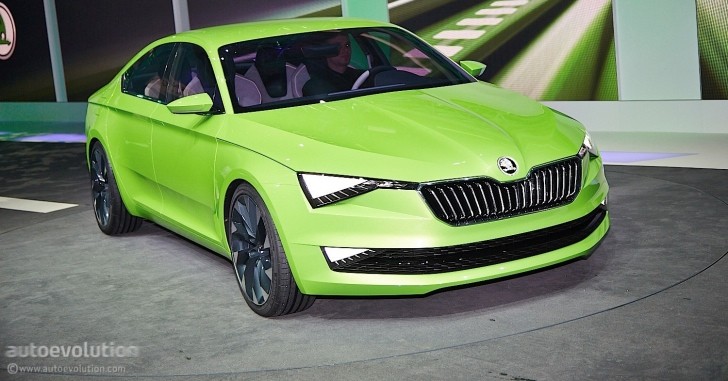The 2014 edition of the Geneva Motor Show is a special one for Skoda, as the Czech producer is looking to go beyond its current status of a practical vehicle producer. Skoda’s first step towards including upmarket offerings in its line comes in the form of the VisionC Concept.
The study is a five-door coupe that is expected to reach production form in 2016 and will be slotted in between the Octavia and the Superb, the current range-topper.
What’s more, the VisionC also offers us a hint on how all future Skoda models will look. Nonetheless, we can’t help notice that Skoda’s future design approach has been brought rather close to SEAT’s design language. This is true for multiple parts of the VisionC, from the profile of the car to details such as the front end.
The VisionC’s cabin is gifted with four individual seats, with Skoda promising plenty of space. Moving to the dashboard, we find plenty of display area, with the central touchscreen unit featuring an unusual layout. What’s more, Skoda has gone for a transparent trim flooded with light, which offers one the impression of snow and ice. Even the rear passengers have their own foldable infotainment screens.
Under the funky shade of Green used here, we find the Volkswagen Group’s MQB modular transverse architecture, shared with vehicles ranging from Skoda’s own Octavia to the SEAT Leon or VW Golf VII.
This means that the production version will offer a broad selection of petrols and diesels. In its efforts to become the world’s number one automaker, the VW has been constantly introducing new engine families, which means there will be plenty of choices.
As for the concept car itself, Skoda has gone with the VW Group trend, fitting the vehicle with a 1.4-liter turbocharged unit that can run on petrol or natural gas. Like we said, this follows a trend, which was set by the VW Golf TGI and the Audi A3 G-Tron.
The powerplant delivers 110 HP and seems to have “eco” written all over it, since its official figures, when running on gas, tell us that it only requires the equivalent of 3.4 liters of petrol for 100 km. As for the CO2 emissions, these were estimated at only 91 grams per km. Skoda explains that, despite the frugal approach, the unit can push the car to a top speed of 213 km/h (133 mph).
What’s more, the VisionC also offers us a hint on how all future Skoda models will look. Nonetheless, we can’t help notice that Skoda’s future design approach has been brought rather close to SEAT’s design language. This is true for multiple parts of the VisionC, from the profile of the car to details such as the front end.
The VisionC’s cabin is gifted with four individual seats, with Skoda promising plenty of space. Moving to the dashboard, we find plenty of display area, with the central touchscreen unit featuring an unusual layout. What’s more, Skoda has gone for a transparent trim flooded with light, which offers one the impression of snow and ice. Even the rear passengers have their own foldable infotainment screens.
Under the funky shade of Green used here, we find the Volkswagen Group’s MQB modular transverse architecture, shared with vehicles ranging from Skoda’s own Octavia to the SEAT Leon or VW Golf VII.
This means that the production version will offer a broad selection of petrols and diesels. In its efforts to become the world’s number one automaker, the VW has been constantly introducing new engine families, which means there will be plenty of choices.
As for the concept car itself, Skoda has gone with the VW Group trend, fitting the vehicle with a 1.4-liter turbocharged unit that can run on petrol or natural gas. Like we said, this follows a trend, which was set by the VW Golf TGI and the Audi A3 G-Tron.
The powerplant delivers 110 HP and seems to have “eco” written all over it, since its official figures, when running on gas, tell us that it only requires the equivalent of 3.4 liters of petrol for 100 km. As for the CO2 emissions, these were estimated at only 91 grams per km. Skoda explains that, despite the frugal approach, the unit can push the car to a top speed of 213 km/h (133 mph).



































